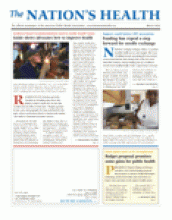Residents of Nebraska and North Carolina are breathing easier these days thanks to indoor smoke-free air laws that recently went into effect in both states. Though separated by time zones and geography, the long road that led to the states’ tobacco protections shared a common mile marker: “The Guide to Community Preventive Services.”
Developed by the Task Force on Community Preventive Services, the “Community Guide,” as it is often called, is a free resource providing evidence-based recommendations about prevention programs and policies that are effective in saving lives and increasing the quality of life. The U.S. Department of Health and Human Services established the task force — an independent, non-federal body — in 1996 to develop the guide to serve as a resource for policy-makers, practitioners, researchers, research funders and other public health decision-makers searching for evidence-based recommendations and findings that will help them allocate their scarce resources to effective programs and policies. The guide tells users what intervention programs and policies work, how well the interventions work, for whom, where and at what cost.

David Brathcher smokes at a Durham, N.C., bar in December. Thanks to public health advocates, some of whom used an evidence-based resource called the Community Guide in their work, a smoking ban went into effect in the state in January.
Photo by Gerry Broome, courtesy AP Images
North Carolina health officials have used the Community Guide “as basically a bible” for community-based and policy interventions, said Walter Shepherd, MA, director of the North Carolina Comprehensive Cancer Program at the North Carolina Division of Public Health and executive director of the North Carolina Advisory Committee on Cancer Coordination and Control. Shepherd credits the Community Guide for contributing to the strategies that led to the passage of North Carolina’s smoke-free law, which went into effect Jan. 2 and requires enclosed areas of almost all restaurants and bars to be smoke-free. Smoking is also banned in enclosed areas of hotels, motels and inns if food and drink are prepared there.
“The guide was a very important tool,” Shepherd, who is an APHA member, told The Nation’s Health. “The evidence shows that smoking bans and restrictions work, and we took it to policy-makers. It is just amazing the progress that has been made. This is a state where just a few years ago members could sit on the floor of the General Assembly and light up a cigarette.”
Similarly, Charlotte Burke, MS, RD, manager of the Division of Health Promotion and Outreach at the Lincoln-Lancaster County Health Department in Lincoln, Neb., credits the Community Guide for helping to clear the air in Nebraska, which on June 1, 2009, became the 16th state in the nation to implement a law prohibiting smoking in workplaces, restaurants, bars and gaming establishments. Public health practitioners in Lincoln have used many of the Community Guide’s tobacco strategies, “and very successfully,” Burke told The Nation’s Health.

The guide is used to support activities such as this workplace health walk in Nebraska.
Photo courtesy Lincoln-Lancaster County, Neb., Health Department
“We were not only able to accomplish a very strong smoke-free ordinance in Lincoln, but that was used as a model for the statewide law that went into effect last June,” Burke said. “Being able to use the proven strategies from the Community Guide as a basis for our processes certainly was beneficial.”
At the heart of the Community Guide are evidence-based recommendations developed from systematic reviews examining what works to promote public health, what does not work, the cost of the intervention and the likely return on investment. The task force — members of which are appointed by the director of the Centers for Disease Control and Prevention — receives technical, scientific and administrative support from CDC. A non-paid body, the task force issues the evidence-based recommendations and findings to the public health community based on the systematic reviews. Community Guide users say the recommendations are valuable because the body of scientific literature on specific health problems can be overwhelmingly large, inconsistent and inaccessible.
“In the old days before the Community Guide and all its wonderful resources were available, you would have to do all the heavy lifting to find out how they came up with that recommendation,” Shepherd said. “The guide has done all that work for us. They give all the rationale. They give links to all the references. They give you guidance as to where to find the information. Everything is pretty much in one place, and that really helps us. It’s easy to access, it’s easy to understand and when we are particularly dealing with community partners, it makes us look really smart.”
The task force will recommend an intervention if the systematic review shows either strong or sufficient evidence of the intervention’s effectiveness. For example, the task force strongly recommends laws requiring the use of child safety seats and laws that maintain the minimum legal drinking age of 21, as well as the use of sobriety checkpoints.

The task force behind the Community Guide has recommended the use of sobriety checkpoints, such as this 2007 one in Miami.
Photo by Joe Raede, courtesy Getty Images
A task force recommendation also contributed to states’ passage of lifesaving legislation making it illegal to operate a motor vehicle at or above .08 blood alcohol concentration. Testifying about evidence-based prevention before the House of Representatives Subcommittee on Health last year, task force Chair Jonathan Fielding, MD, MPH, MBA, director and health officer of the Los Angeles County Department of Public Health, noted that the blood-alcohol recommendation “bolstered the evidence base to enable legislation limiting access to transportation funds to states that permitted higher alcohol levels, contributing to safer roads and saving lives.”
When the task force lacks sufficient evidence to determine whether an intervention achieved the desired outcome, a finding of “insufficient evidence” is made, indicating that additional research is needed. The task force can also recommend against the use of an intervention if it is proven to have no benefit or to cause substantial harm that outweighs any benefits. For example, users searching for youth-focused violence-prevention interventions will find that the task force recommends against policies that would facilitate transferring youths from juvenile to adult criminal justice systems for the purpose of reducing violence, “based on strong evidence that these laws and policies are associated with increased subsequent violent behavior among transferred youth,” the finding states.
To date, the task force has assessed the effectiveness of more than 210 public health interventions across 18 topic areas that include adolescent health, alcohol, asthma, birth defects, cancer, diabetes, HIV/AIDS, mental health, motor vehicle safety, nutrition, obesity, oral health, physical activity, social environment, tobacco, vaccines, violence and workplace health. The task force’s recommendations and findings are available at www.thecommunityguide.org, and in print in “The Guide to Community Preventive Services: What Works to Promote Health?” However, users are encouraged to visit the Community Guide’s Web site for reviews that have been completed since the book was published in 2005.
“I can’t think of a better investment of taxpayer money than determining what works in a rigorous and consistent way, free from commercial interests and free from some of the conflicts that have plagued other efforts,” Fielding, who is an APHA member, told The Nation’s Health. “Our hope is that there will be enough resources so that we are able to cover the entire spectrum of opportunities for health improvement and disease prevention and health protection.”
Thus far, a limited budget has not permitted the task force to assess the effectiveness of as many health interventions as needed by practitioners and policy-makers, Fielding said. Additionally, raising awareness of the Community Guide and its evidence-based findings has been a challenge, “but progress is definitely being made.”
“The Community Guide’s findings and recommendations are important,” said APHA member Shawna Mercer, PhD, MSc, chief and director of the Guide to Community Preventive Services at CDC. “So the question becomes how to most effectively get these findings into the hands of the people who need them — the practitioners, the policy-makers, the researchers, the research funders and on-the-ground public health programs. We are actively seeking to find ways to disseminate this information more effectively.”
One bridge that has proven effective for disseminating the task force recommendations is the 28-member and growing body of official Community Guide liaisons who hail from federal agencies and professional non-profit health organizations. Serving at the invitation of the task force chair, the liaisons — which include an APHA representative — volunteer their resources to all aspects of the Community Guide’s work, helping to disseminate the evidence-based findings and recommendations to their members and constituents.
“In these resource-scarce times, helping to ensure that this critical information doesn’t just sit on the shelf, but in fact gets into the hands of the people who need it at the time they are making decisions, is an important role, and we are honored to have been invited by the Task Force on Community Preventive Services to serve as a liaison organization,” said APHA Executive Director Georges Benjamin, MD, FACP, FACEP (E). “We stand ready to help disseminate the critical findings and recommendations of the task force and to assist our members in translating them into real-world action.”
For more information on the Guide to Community Preventive Services, visit www.thecommunityguide.org.
- Copyright The Nation’s Health, American Public Health Association









